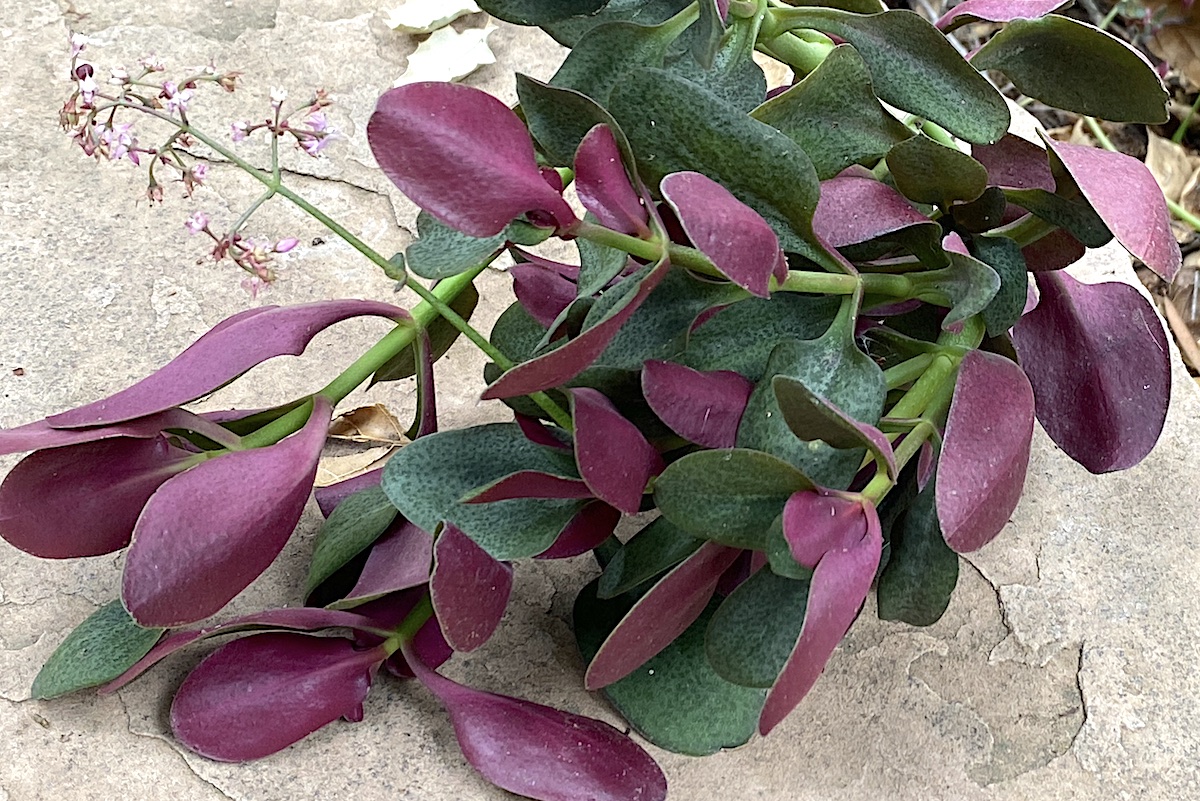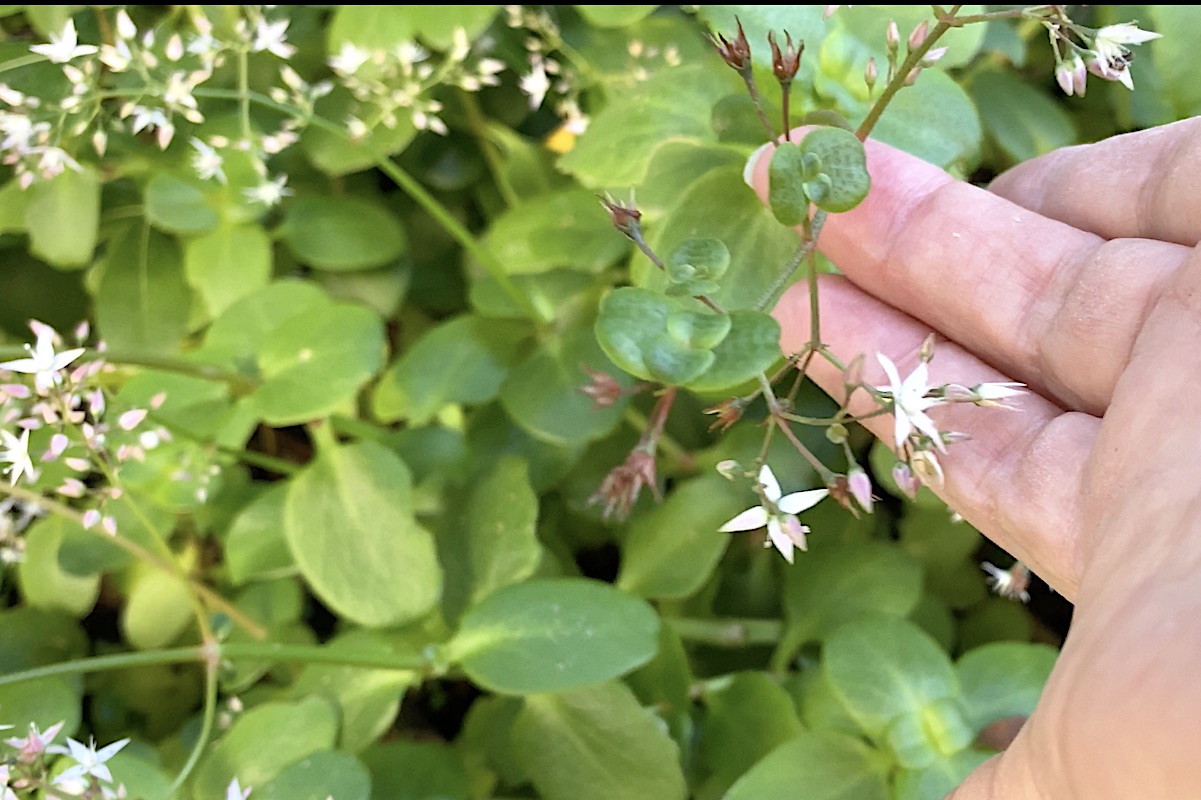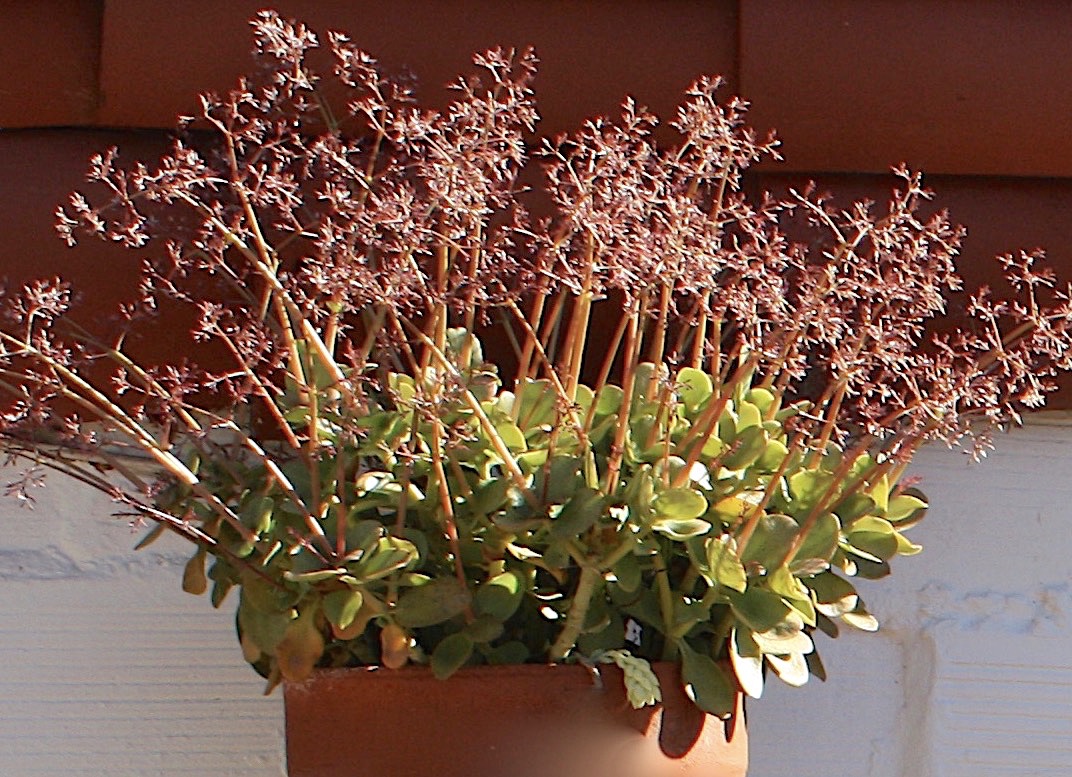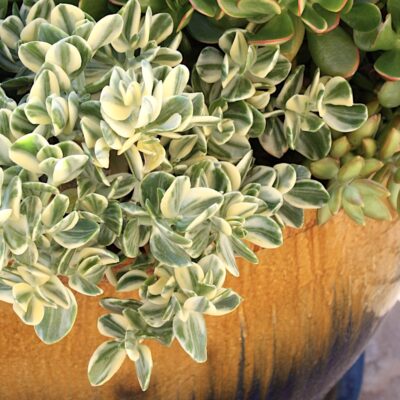
Grow Shade-Loving Fairy Crassula
Fairy crassula (Crassula multicava) is a great succulent ground cover for shade. I've grown it since the '90s under oaks on a steep slope. It has sentimental value: My dad gave me cuttings. But like its cousin jade (Crassula ovata), this simple green succulent gets no respect. What is it with us gardeners that we sneer at easy-care plants that work well where nothing else does? "Common" isn't a compliment!
Case in point: At Waterwise Botanicals nursery, I ran into an old friend who is a renowned succulent gardener. He was curious what I had in my cart. I showed him what I'd found that intrigued me. He barely glanced at it. "Oh that," he said dismissively. "I had to pull it out of my garden because it was taking over."
I stammered, "Yes, but this one has red on the underside of its leaves!" But he'd moved on. Maybe he already knew about Crassula multicava 'Red' and wasn't impressed. Yet I thought it gorgeous, and it's doing as well in my garden as dad's good ol' green one. As for the species taking over, certainly it spreads, but slowly. It's never been a problem. In fact, I like how it fills gaps.

Crassula multicava 'Red' (red fairy crassula) has other cultivar names, including 'Purple Dragon' and 'Ngabara'.
In winter, typical of the genus, fairy crassula produces dainty star-shaped, pinkish-white flowers. By spring, masses of airy blooms on slender, branching stems dance above oval green leaves. That is, if frost doesn't get them...which is likely why mine is less vigorous. Nearly every winter, frost hits exposed garden areas, keeping tender plants in check. But fairy crassula is an understory plant regardless. In summer, if out in the open, it may sunburn (I'm inland CA, Zone 9b).

Crassula multicava plantlets
It's fascinating how fairy crassula spreads. As flower stalks elongate, they produce itty-bitty plantlets that become heavier and more pendant. When about dime-sized, they touch the ground and take root. This happens far enough from the mother ship that plantlets don't compete for light and nutrients.
As for Crassula multicava being invasive, If you happen to have ideal conditions for succulents---temps between 40 and 90, low humidity, good soil, and bright shade---it may be more vigorous than you prefer. In less-than-ideal gardens, you'll love it and it'll love you. In any case, as I show in my video, it's easily removed: a gentle yank uproots it.

Smaller, lighter green leaves and red stems indicate that this potted Crassula multicava is getting more sun than normal. But that's fine near the coast.
15 reasons to grow fairy crassula (Crassula multicava)
- It's a great beginners' succulent that starts readily from cuttings.
- It tolerates difficult conditions: poor soil, deep shade, steep terrain.
- It appreciates regular water but gets by without it.
- Dark green mounds look good close up or far away.
- It's free. Look for it at plant swaps and ask neighbors for cuttings.
- Messy tree leaves fall into the plants and disappear. (To recall its name, I think "multiple caves.")
- It causes tree leaves to decompose into rich, crumbly leaf mulch.
- It keeps weed seeds from germinating by robbing them of sunlight.
- It diffuses the impact of rain, reducing soil erosion.
- Its shallow roots don't compete with those of trees or shrubs.
- Dainty white flowers contrast beautifully with deep green leaves.
- Flower stalks, bejeweled with starlike blooms, are lovely backlit.
- It needs almost no care and is pest- and problem-free. Even snails don't bother it.
- It's pretty in pots and as a filler in hanging baskets (prune to encourage fullness).
- Like most succulents, you shouldn't walk on it, but it recovers if you do.
See Crassula multicava in my garden and watch me start cuttings of 'Red' in my new video: A Shade Succulent I Love and You Will Too (4:35).
On this site
Crassula (Jade and More): Details, Photos and Varieties
Crassulas are among the easiest, most trouble-free succulents to grow, with one caveat: With few exceptions, they’re frost-tender (tend to be damaged when temperatures drop below 32 degrees F). Shrub varieties are very easy to start from cuttings, and stacked jades will send forth whiskery roots from between their tight leaves—simply snip off the stem and bury in potting soil so that roots are covered (it’s OK to bury a few leaves too). Crassulas, like aloes, also stress beautifully to shades of red, yellow and orange. Give variegated varieties adequate sun or they’ll revert to solid green.


Hi Debra,
Love your Blog! My new favorite is Senecio ‘Everest’ (Monrovia) it is upright with rosemary-like blue gray leaves along its stems and gets about 3′ tall X 3′ wide.
Tina Cremer
Wow, it’s gorgeous! That pale baby blue! Thanks, Tina!
Re: Fairy Crassula
Thank you for the article. I believe I bought mine at Waterwise also. I think I now know why my is almost dead. Too much sun. It is so pretty, I will either transplant mine or if it is too far gone, I’ll get another. This time I will know where to plant it.
Hi Marilyn — The best way to grow something is to kill it first. Waterwise has plenty and lots of the red variety. I know it’ll do well for you, now that you know what not to do! ;+)
Having difficulty finding fairy crassula on line for delivery (Covid quarantine).
Hi Bonnie — Fairy crassula (Crassula multicava) is so common, most nurseries don’t bother with it. It’s a “pass-along plant” (neighbors pass it along). Mountain Crest Gardens sells it mail-order, but they’re out at the moment. Suggestions:
Look for it in friends’ and neighbors’ yards. If they have it, they’ll happily share cuttings.
Look for it at neighborhood or garden-club plant swaps.
Post a photo of it on your community Next Door site, asking if anyone has it and if they’d share cuttings.
If none of those work, then it probably doesn’t grow in your area. (Good to know.)
P.S. Tom Jesch, general manager of Waterwise Botanicals nursery, says they’re gearing up to sell mail-order. Since they’re the only source of Crassula multicava ‘Red’ (the one with burgundy-red on the underside of the leaves) that’s very good news indeed. I’ll post an update when it’s available, hopefully soon!
Just today I removed a whole bed of fairy that had grown up in a year. It’s all you have said about it and easy to remove. Even a black thumb could manage this one.
Yay! Thanks for letting us know, Nan.
Debra
Great info on Crassula multicava.
I had a Horticulture professor say, a weed is a plant growing where you don’t want it to grow.
Like most things in life plant use is situational.
If you’re a plant collector Crassula multicava could seem like a weed. If you have Poa annua
(annual blue grass) growing in your garden, it’s a weed yet golf courses in San Diego use Poa annua on golf greens. Why? Because it’s tough.
Crassula muticava is tough. It’s simple, it’s fireproof, binds slopes, looks very natural under oaks, pines, eucalyptus and other tall trees the let the sun dapple through.
It’s a great carpet for larger succulents, my favorite being Aloe cameronii. Both are tough and there’s great color contrast of greens and oranges.
Sometimes a tough situation calls for tough plants. Keep Crassula multicava on you list of problem solvers.
Hi Bill — Hearing this from you lends great credibility to my post and video. Thank you! I’m going to try it with Aloe cameronii! Thanks again, too, for your help with my “Landscape Designer’s Favorite Aloes”
I love fairy crassula and grow it in hanging pots which is how it first came to me. As an East Coast transplant to Santa Cruz I was cautious about succulents for years. When my elderly neighbor passed away his daughter let me select some leftover plants. I picked the hanging pot of Crassula muliticlava. I’ve had that same plant going on twenty years now and still love it, and utilize it as a mother plant for starts. I am no longer shy about succulents – I have hundreds in my barnyard nursery, including fairy crassulas.
That’s wonderful! Thanks for sharing, Jeannie.
Anxious for shade succulents video. I loved seeing you at SD home and garden. Thank you.
Thanks for the boost, Sara! I’m working on it! It’s a slippery subject though. So many succulents can go either way…
I recently purchased the Crassula multicava ‘Red’ – I just loved the colors. I am debating whether to plant in the ground. Do these prefer shade as well? Unfortunately I was unable to open and view the video! Thank you!
Where are you located?
I am in Bay area, CA zone 9.
Yes, grow it in a bright shade location. This reminds me, mine got scorched during the recent heat waves. It was doing great until the neighbor trimmed the tree that was shading it. Poor thing looks awful. I should have covered it.
Thank you so much for your reply! I am sorry to hear about your plant, I lost a couple of my succulents too 🙁
I will move my ‘red’ to a bright shady location. I am looking forward to see how it grows.. this plant has such a beautiful color!
I just bought C. multicava ‘Purple Dragon’ and am hoping it isn’t quite as vigorous as the species, which I have been trying to rid my front yard of for 2 years. However, after reading your 15 reasons to grow it, I definitely appreciate it more and will try to find a better location for the red-leaved cultivar where it won’t take over nearby plants. Thanks for your excellent advice about growing this species!
I’d love it if the red-leaved variety would take over! So far it just sits there, but to be fair, it’s probably getting too much sun after a neighboring tree was removed. I may have to find a better place for it.
I was very disappointed when I tried to view your video repeatedly, only to be told each time: “!Not Available!” I just recommended this article for an acquaintance from a plant trading group, who has all but given up on finding something that will grow under her Oak tree! LOL I hope you get your video up & running again! I have yet to see it!
Hi Pam — I’m grateful to you for letting me know. Fixed!
Debra
Debra Lee, I have a beautiful Fairy Crassula in my greenhouse here in Oklahoma. It bloomed this late winter and spring and the blooms have played out. I was wanting to trim them back but didn’t know if I should cut them back to the main stem or just under the bloom stalk. Thank you. Robert
Hi Robert — I pinch off spent flower stems (which I find messy) where they emerge from the plant. Debra
Thank you for this informative post!
I live in Palm Desert zone 9B and of course it gets hot in the summer, 90° to 110°. I’ve been leaving this plant out all winter and it has done beautifully. Now that it’s getting hot ,90° +, can I continue to leave this outside? Thank you for your consideration ~
Only in the shade. Your climate is similar to mine (north of San Diego in the foothills, inland) and fairy crassula suffers in the high heat of summer in a sunny location.